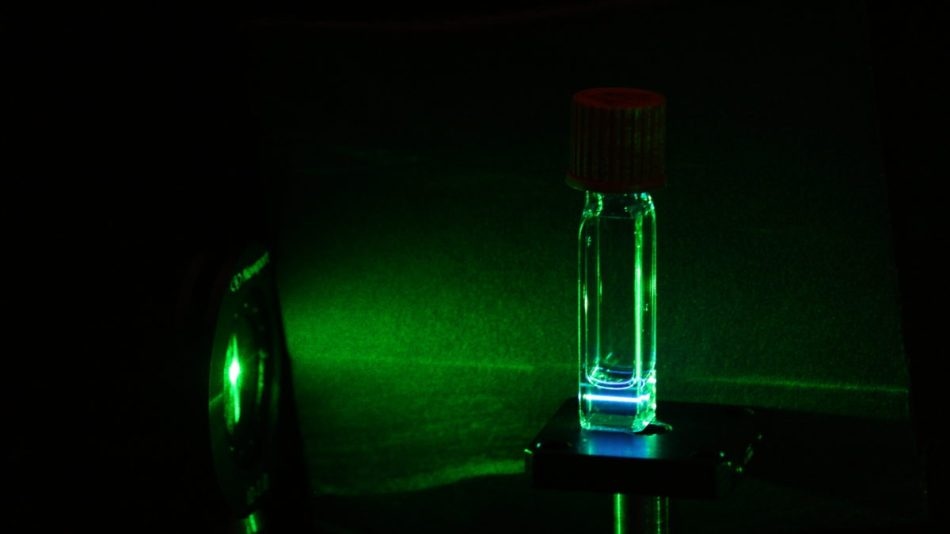Dec 3 2019
A group of scientists from The University of Texas at Austin and the University of California, Riverside has discovered a new technique to create a long-proposed phenomenon—the energy transfer between organic, carbon-based molecules and silicon.
 A green laser light goes through the silicon quantum dots, and the silicon quantum dots re-emit blue light in a first-ever process of up-conversion involving silicon. Image Credit: Lorenzo Mangolini and Ming Lee Tang/UC Riverside.
A green laser light goes through the silicon quantum dots, and the silicon quantum dots re-emit blue light in a first-ever process of up-conversion involving silicon. Image Credit: Lorenzo Mangolini and Ming Lee Tang/UC Riverside.
This innovation could have implications for the storage of information in quantum computing, medical imaging, and conversion of solar energy. The study has been described in a paper published recently in the Nature Chemistry journal.
Apart from being one of the most abundant materials on Earth, silicon is a vital component in a range of applications, from the semiconductors powering computers to the cells used in almost all solar energy panels. However, despite its abilities, silicon poses some difficulties with regard to the conversion of light into electricity.
Different colors of light are made of photons—particles that carry the energy of light. Although silicon has the ability to efficiently transform red photons into electricity, when it comes to blue photons, which carry twice the energy of red photons, silicon tends to lose a major portion of the energy as heat.
The new findings offer researchers with a technique to increase the efficiency of silicon by combining it with a carbon-based material that transforms blue photons into pairs of red photons, which can be more efficiently utilized by silicon. It is also possible to tweak this hybrid material to work in reverse—absorbing red light and transforming it into blue light—which has implications for quantum computing and medical treatments.
“The organic molecule we’ve paired silicon with is a type of carbon ash called anthracene. It’s basically soot,” stated Sean Roberts, an assistant professor of chemistry at UT Austin. The paper illustrates a technique for chemically pairing silicon with anthracene, thus developing a molecular power line that enables the transfer of energy between silicon and the ash-like substance.
We now can finely tune this material to react to different wavelengths of light. Imagine, for quantum computing, being able to tweak and optimize a material to turn one blue photon into two red photons or two red photons into one blue. It’s perfect for information storage.
Sean Roberts, Assistant Professor of Chemistry, UT Austin
For the past 40 years, researchers have proposed that connecting silicon with a kind of organic material that better absorbs green and blue light could be the solution to enhancing the ability of silicon to convert light into electricity.
However, just layering the two materials did not bring about the expected “spin–triplet exciton transfer,” a specific kind of energy transfer from the carbon-based material to silicon, which is required to achieve this goal.
Roberts and materials scientists from UC Riverside elucidate the way they overcame this by using tiny chemical wires that pair silicon nanocrystals to anthracene, creating the proposed energy transfer between them for the first time.
The challenge has been getting pairs of excited electrons out of these organic materials and into silicon. It can’t be done just by depositing one on top of the other. It takes building a new type of chemical interface between the silicon and this material to allow them to electronically communicate.
Sean Roberts, Assistant Professor of Chemistry, UT Austin
This effect was measured by Roberts and Emily Raulerson, his graduate student, in an exclusively designed molecule that binds to a silicon nanocrystal, the breakthrough achieved by collaborators Ming Lee Tang, Lorenzo Mangolini, and Pan Xia of UC Riverside.
Roberts and Raulerson used an ultrafast laser and discovered that the new molecular wire between the two materials was not just fast, efficient, and resilient, but it could perform effective transfer of nearly 90% of the energy from the nanocrystal to the molecule.
“We can use this chemistry to create materials that absorb and emit any color of light,” stated Raulerson, according to whom, with further tweaking, similar silicon nanocrystals paired with a molecule could pave the way to a range of applications, from miniature electronics to battery-less night-vision goggles.
Earlier, other highly efficient methods of this type, known as photon up-conversion, were dependent on toxic materials. Since the new method specifically makes use of nontoxic materials, it paves the way for applications in bioimaging, human medicine, and environmentally sustainable technologies, something that Roberts and fellow UT Austin chemist Michael Rose are working toward.
Tang’s lab at UC Riverside pioneered the way to pair the organic molecules with the silicon nanoparticles, and Mangolini’s team designed the silicon nanocrystals.
The novelty is really how to get the two parts of this structure—the organic molecules and the quantum confined silicon nanocrystals—to work together. We are the first group to really put the two together.
Lorenzo Mangolini, Associate Professor of Mechanical Engineering, UC Riverside
The authors of the paper include Devin Coleman and Carter Gerke from UC Riverside.
This study was funded by the National Science Foundation, the Robert A. Welch Foundation, the Research Corporation for Science Advancement, the Air Force Office of Scientific Research, and the U.S. Department of Energy. In addition, Raulerson holds the Leon O. Morgan Graduate Fellowship at UT Austin.